Let's start at the beginning; no prior Thai reading experience is required!
To read Thai, we must understand how an
orthographic syllable is constructed. The first thing to note is that we're going to be careful
to distinguish between an orthographic—that is, written—syllable and a
phonetic syllable. The reason for this will become
clear later on. Don't worry about this too much now; just remember to be flexible about your old grammar-school idea of a syllable. So let's
start by dissecting a written syllable in Thai.
Syllable Basics
First, let's note that, like English, the Thai alphabet is divided into
consonants and
vowels. Before continuing this lesson,
take a moment to look at the
consonants reference page. If it's convenient on your computer, you might want to
keep it open in another window while you read on.
You probably noticed that each consonant has two sounds associated with it: one for when it appears at the beginning of a syllable and one for when it
appears at the end of syllable. This provides our first clue to the
Anatomy of a Spoken Thai Syllable. We'll be working with the following
diagram throughout this lesson.
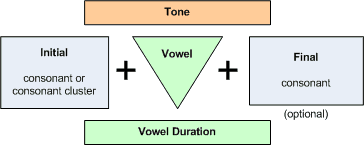
This diagram represents what you will be
thinking about when you actually speak a Thai syllable aloud. In other words, you'll always pronounce the
initial consonant first, then
the vowel sound, and end with the
final consonant sound. This may seem obvious, but it's important because
as we study reading and writing Thai, you'll find that the position of the letters (or
graphemes) as you read from left to right sometimes doesn't proceed
in this same order.
We'll soon be plugging consonant
graphemes into both of these
boxes. Keep your consonant reference chart handy; when a letter appears in the 'Initial' box, we'll look up its sound from the column marked
initial,
and when it appears in the 'Final' box, we'll look up its sound from the column marked
final.
You might have noticed in the consonant chart that a few consonants do not have a syllable-ending sound defined (marked 'n/a' in the chart). They can never appear in the 'Final' box.
• In the light-green box marked Vowel, you can expect to pronounce any of the thirty (or so) vowel sounds.
The vowel sound can be long (
สระเสียงยาว

/sa
L ra
L siiang
R yaao
M/) or short (
สระเสียงสั้น

/sa
L ra
L siiang
R san
F/), which refers to the relative amount of time that the vowel
sound is held. You'll want to get the vowel duration correct to be sure you're understood. Some syllables stop there; they don't have a final consonant sound.
This is called an
open syllable. I'm sure you can think of some open syllables in English, like
we, or all three syllables of
patio. In these cases, the 'Final'
consonant box in our diagram will be left empty. If the optional final consonant sound is present, then the syllable is called
closed. In English, like
cat which
ends with consonant /t/.
To complete our introduction to the syllable diagram, I'll point out that the overall syllable must
be spoken with the correct tone, which is one of the following: low (
เสียงเอก
/siiang
R aehk
L/), mid (
เสียงสามัญ

/siiang
R saa
R man
M/), high (
เสียงตรี
/siiang
R dtree
M/), falling (
เสียงโท
/siiang
R tho:h
M/), or rising (
เสียงจัตวา
/siiang
R jat
L dta
L waa
M/). The proper tone to use is determined by a
few different factors, such as the
class of the initial consonant, the vowel duration, and the type of final consonant, if any.
For the rest of this article, we'll continue discussing the basic alphabetic composition of the syllable, but please remain aware of the other characteristics of the syllable that must be properly pronounced:
the correct
vowel duration and
tone.
You're now ready to read your first word in Thai. Don't click the speaker icon yet.
Let's see if you can piece it together yourself. Refer to your
consonant page to determine the sound for
ก when it's an initial consonant. Also look up the sound for
บ when it's a final
consonant. On the
vowels reference page, you'll find the vowel อ
ั in row 1 of the basic vowel sounds, but I'll help you out: this vowel symbol represents
an /-a-/ sound. As you can see, this grapheme is written above—and a little bit to the right of—the initial consonant. This chart also tells us that it's a short-duration vowel sound.
Determining the tone is a little more involved, but in case you're curious at this point, the low tone is determined by the fact that
ก is a mid-class consonant, and
บ is
a
dead ending. Refer to the
tone rules page for more information.
Putting it all together, this syllable (and word) is pronounced /gap
L/ (note: In your site
control panel, you can configure the system used for displaying
Romanizations on this page; if you're a linguistics student, you might want to select
IPA transcription). Now practice saying the word and carefully compare with the audio clip. That was simple! Congratulations on reading your first word in Thai.
Next, we'll look at a syllable without a written vowel. If no vowel symbol appears in the syllable, then the vowel sound /-oh-/ is implied. (This special vowel appears in row 6 of the vowel chart, where it says
[unwritten].)
I hope you didn't have to refer to the consonant chart because this syllable uses the same initial and final consonants as above. The only
difference is the absence of a written vowel. This is pronounced, /gohp
L/. Did you get it right?
Vowel Orthography
Earlier, I mentioned that the ordering of the letters in written Thai can be unexpected sometimes. In particular, some vowel characters are written in
places that might seem strange to a student familiar only with western languages.
- In Thai, Vowel characters can be written above, below, before (in front of), and/or after the initial consonant.
- However, syllables are still always spoken in the same order: initial + vowel + final.
Keeping this in mind, now examine the fifteen basic vowel
graphemes (symbols). All vowel and
diphthong symbols are built up from one or more of these parts. Memorize them, concentrating
on differentiating them from the forty-four consonant graphemes. You must be able to distinguish Thai consonants from vowels. It won't be hard, though, because you'll soon realize that they
generally don't look like each other at all, with a few exceptions. For example, study the difference between the vowel grapheme
โ and the consonant grapheme
ร.
The Fifteen Basic Vowel Graphemes
preposed (written before the initial consonant):
เ แ โ ใ ไ
postposed (written after the initial consonant):
ะ า ำ
superposed (written above the initial consonant): อ
ั อ
ิ อ
ี อ
ึ อ
ื
subposed (written underneath the initial consonant): อ
ุ อ
ู
superposed vowel shortening mark: อ็
The consonants
ย,
ว, and
อ can also appear as part of a
compound vowel symbol.
Here's an example where the vowel is placed
below the inital consonant. Also, there's no final consonant.
Did you look up the initial consonant in the consonant chart? Did you find the vowel in row 9 of the vowel chart? The Romanization is /nguu
M/. As for figuring out the tone: being an
open syllable with a long duration vowel, the syllable
is
live. Since
ง is a
sonorant (low-class) consonant, the spoken tone is 'mid.'
Perhaps the most startling case is when the vowel is written
before the initial consonant. It bears repeating, though: even with a
preposed vowel, the syllable is
still spoken in the order: initial + vowel + final. Our diagram always shows the order of
speaking the sounds.
I'm sure this was one of the first words you learned when you studied spoken Thai: /mai
F/. Study this case carefully until you're comfortable with the idea of the vowel
sound coming after the initial consonant, despite the vowel
symbol being written before it.
We aren't discussing the
tone marks here yet, but in this case, the stroke over the initial consonant is the first of the four tone marks used in Thai. In this case, it gives the syllable
a 'falling' spoken tone.
Don't mistake the four tone marks for vowels:
อ่ อ้ อ๊ อ๋
Some vowels combine several 'pieces' which surround the initial consonant, but they still count as a single vowel sound. Here's a more complex case.
Study this case carefully. The vowel insinuates itself all around the initial consonant and the final consonant is tacked on the end. Notice that this
compound vowel symbol incorporates
three different symbols which surround the initial consonant on three sides. You can find this vowel in row 10 of the
diphthong section of the vowels page. The
consonant
ย is considered part of the vowel. Later, we'll be introducing the terminology "straddling" to describe how a vowel with a
preposed
element surrounds the initial consonant. Did you sound out the word yet? You should have gotten something like /dtiiang
M/.
As mentioned above, the consonants
ย,
ว, and
อ can appear as part of a compound vowel symbol. Such symbols represent a diphthong (combined vowel sound). There are
three diphthongs in Thai, shown in rows 10, 11, and 12 of the
vowels table. Each starts with a different "high" vowel and moves towards /-a/. In this role, the consonants are
not acting as initial consonant or final consonant. Think
of them as just a part of the vowel symbol. It's a little confusing because
ย and
ว can also serve as final consonant "glide" endings, as shown in sections 4 and 5 of the vowels page.
Final ร with an Implied Vowel
When the consonant
ร is used as a final consonant in a syllable with no written vowel, it is usually pronounced /-aawn/.
Final Cluster /-รถ/ or /-รท/
A
consonant cluster is any grouping of two consonants that are stated together without a written vowel. We'll spend most of
Part II of this article
discussing consonant clusters which act as the
initial consonant in a syllable. But first, we'll introduce a cluster that takes the place of the
syllable's final consonant:
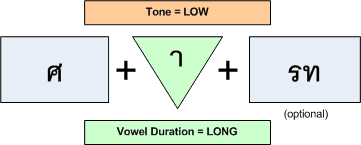 |  | ศารท  /saatL/ (harvest time; harvest festival in the 10th lunar month) /saatL/ (harvest time; harvest festival in the 10th lunar month) |
Now we've got two letters in the final consonant box. In the clusters /-
รถ/ and /-
รท/, the
ร is silent, so we simply pronounce a final /-t/ sound, and the word is
pronounced /saat
L/. A two-syllable word that uses this type of cluster is
สามารถ 
. See if you can puzzle out the pronunciation before clicking on the word (or speaker) to see
(or hear) the answer.
What if we were to place a consonant cluster in the
initial consonant box? In
part II, we'll begin to examine how to read words that do this.






 /saL raL siiangR yaaoM/) or short (สระเสียงสั้น
/saL raL siiangR yaaoM/) or short (สระเสียงสั้น
 /saL raL siiangR sanF/), which refers to the relative amount of time that the vowel
sound is held. You'll want to get the vowel duration correct to be sure you're understood. Some syllables stop there; they don't have a final consonant sound.
This is called an open syllable. I'm sure you can think of some open syllables in English, like we, or all three syllables of patio. In these cases, the 'Final'
consonant box in our diagram will be left empty. If the optional final consonant sound is present, then the syllable is called closed. In English, like cat which
ends with consonant /t/.
/saL raL siiangR sanF/), which refers to the relative amount of time that the vowel
sound is held. You'll want to get the vowel duration correct to be sure you're understood. Some syllables stop there; they don't have a final consonant sound.
This is called an open syllable. I'm sure you can think of some open syllables in English, like we, or all three syllables of patio. In these cases, the 'Final'
consonant box in our diagram will be left empty. If the optional final consonant sound is present, then the syllable is called closed. In English, like cat which
ends with consonant /t/. /siiangR aehkL/), mid (เสียงสามัญ
/siiangR aehkL/), mid (เสียงสามัญ
 /siiangR saaR manM/), high (เสียงตรี
/siiangR saaR manM/), high (เสียงตรี /siiangR dtreeM/), falling (เสียงโท
/siiangR dtreeM/), falling (เสียงโท /siiangR tho:hM/), or rising (เสียงจัตวา
/siiangR tho:hM/), or rising (เสียงจัตวา /siiangR jatL dtaL waaM/). The proper tone to use is determined by a
few different factors, such as the class of the initial consonant, the vowel duration, and the type of final consonant, if any.
/siiangR jatL dtaL waaM/). The proper tone to use is determined by a
few different factors, such as the class of the initial consonant, the vowel duration, and the type of final consonant, if any.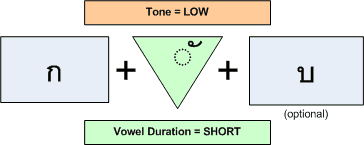

 (with; to; for)
(with; to; for)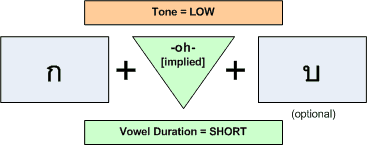


 (frog)
(frog)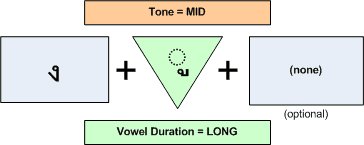

 (snake)
(snake)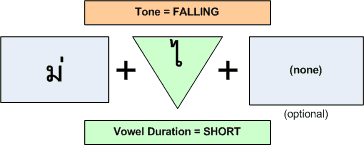

 (not; no)
(not; no)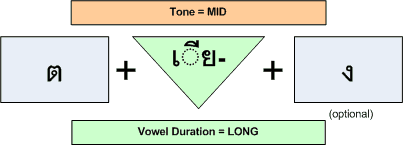

 (bed)
(bed)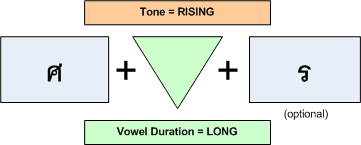

 /saawnR/ (arrow)
/saawnR/ (arrow)

 /saatL/ (harvest time; harvest festival in the 10th lunar month)
/saatL/ (harvest time; harvest festival in the 10th lunar month) . See if you can puzzle out the pronunciation before clicking on the word (or speaker) to see
(or hear) the answer.
. See if you can puzzle out the pronunciation before clicking on the word (or speaker) to see
(or hear) the answer.